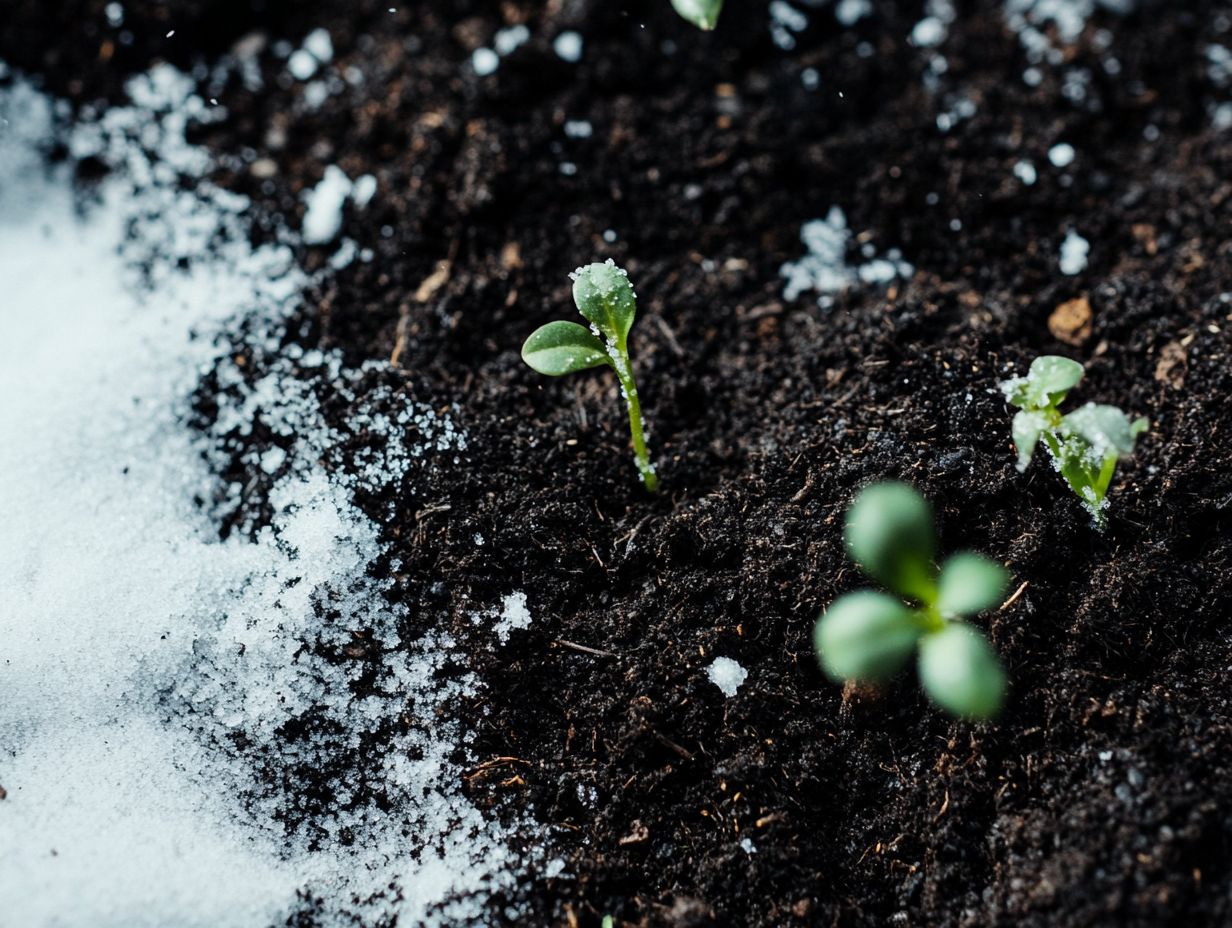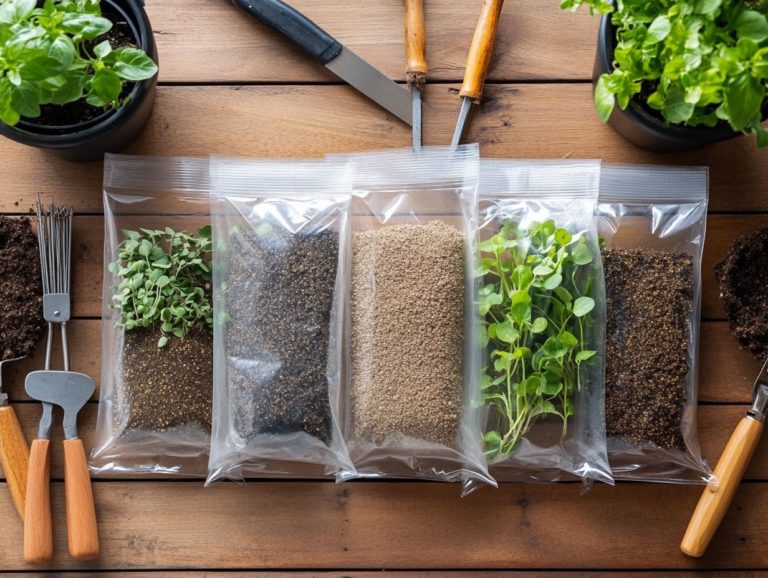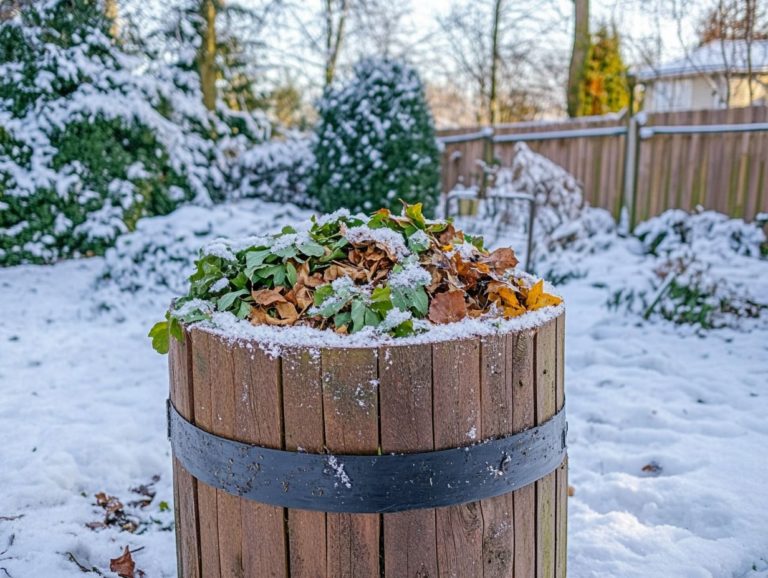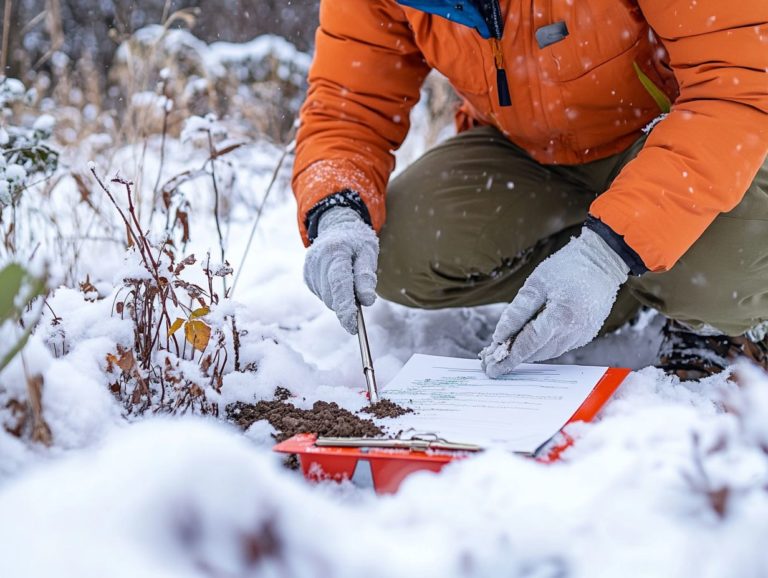Soil Amendments Effective for Cold Climates
In colder climates, nurturing healthy soil can indeed be a challenge, but using the right soil amendments can transform your gardening experience.
This article delves into a range of effective strategies, from composting and mulching with straw to incorporating bone meal and utilizing vermicompost. You ll discover the numerous benefits these amendments offer, enhancing nutrient availability, improving soil structure, and boosting plant resilience in harsh conditions.
Whether you re a seasoned gardener or just starting to explore your green thumb, you ll uncover practical tips to ensure your garden thrives, regardless of the chill in the air.
Contents
- Key Takeaways:
- 1. Using Compost
- 2. Mulching with Straw
- 3. Adding Gypsum
- 4. Adding Manure
- 5. Using Leaf Mold
- 6. Adding Bone Meal
- 7. Using Vermicompost
- 8. Incorporating Fish Emulsion
- 9. Using Green Manure
- 10. Adding Blood Meal and Winter Protection
- 11. Using Seaweed and Cover Crops
- 12. Incorporating Coffee Grounds and Nutrient Cycling
- 13. Using Biochar for Soil Health
- 14. Adding Azomite and Nutrient Levels
- 15. Using Rock Dust for Erosion Control
- What Are Soil Amendments, Organic Amendments, and How Do They Work?
- What Are the Benefits of Using Soil Amendments and Organic Mulch in Cold Climates?
- How Can Soil Amendments and Composting Improve Cold Climate Soil?
- What Types of Soil Amendments, Organic Fertilizers, and Agricultural Practices Are Most Effective in Cold Climates?
- How Often Should Soil Amendments Be Applied in Cold Climates?
- Frequently Asked Questions
- Can soil amendments be effective in cold climates?
- What are some common types of soil amendments for cold climates?
- How do soil amendments help in cold climates?
- Can soil amendments prevent soil from freezing in cold climates?
- Do soil amendments need to be applied differently in cold climates?
- Are there any specific considerations to keep in mind when using soil amendments in cold climates?
Key Takeaways:

- Incorporating compost into cold climate soil can improve its structure, drainage, and nutrient content, leading to healthier plant growth.
- Mulching with straw can protect soil from extreme temperature fluctuations and reduce weed growth, while also adding organic matter to the soil.
- Adding gypsum can help improve soil texture, drainage, and aeration, making it easier for plants to establish and grow in cold climates.
1. Using Compost
Using compost in your winter garden is a game-changer. It greatly enhances soil health and enriches organic matter.
This practice simplifies growing healthy crops and boosts nutrient levels during chilly months. By incorporating compost, you unlock nutrient cycling (the process of nutrients moving through the ecosystem).
Essential minerals become readily available, supported by vibrant microbial activity. This activity breaks down organic matter and nurtures a diverse community of microorganisms.
When you apply compost, you also enhance your soil’s moisture retention. This is crucial for keeping your garden bed intact during heavy rains.
It improves drainage and combats compaction, allowing your cool-weather crops to establish robust root systems. The result? Stronger, more resilient plants thriving throughout the winter growing season.
2. Mulching with Straw
Mulching with straw offers you an exceptional layer of organic mulch that effectively retains soil temperature, minimizes winter weeds, and shields your garden beds from the harsh winter elements.
Straw is a fantastic natural material that really boosts moisture retention, ensuring that your soil remains hydrated for extended periods, which is crucial during those dry spells. As the straw breaks down, the structure of the soil improves, contributing valuable organic matter that enriches nutrient availability for your plants.
Plus, this mulch attracts beneficial organisms like earthworms and microbes, which are essential for promoting soil health.
To apply straw mulch effectively, spread a layer about 2 to 4 inches thick around your plants, making sure not to suffocate them. Managing the decomposition process is quite simple; regularly turning the mulch will help aerate it, ensuring quicker breakdown and preventing overly compacted layers.
3. Adding Gypsum
Incorporating gypsum as a soil amendment can significantly enhance the structure of your soil by reducing compaction and elevating nutrient levels, particularly in heavy clay soils.
This process not only promotes superior drainage and aeration but also enables roots to access essential nutrients and water more efficiently. When applied correctly, gypsum breaks down dense soil layers, facilitating the movement of air and moisture key components for nurturing a vibrant ecosystem.
For optimal results, consider applying gypsum in the spring or fall at a rate of about 1 to 2 tons per acre, tailored to your specific soil conditions. Regular assessments of your soil s structure and health will further inform your adjustments, ensuring you maximize these benefits for robust plant growth.
4. Adding Manure
Adding manure to your garden beds is a game-changer for enriching soil nutrients. It provides essential organic fertilizers that enhance soil health and promote nitrogen fixing crucial for thriving crops in your winter garden.
You have a variety of manure types at your disposal, each offering unique benefits in terms of mineral and nutrient content. Cow, horse, chicken, and sheep manure all bring something special to the table.
Before applying any manure, it’s vital to compost it first. This step minimizes pathogens and weed seeds that could harm your plants and soil health. Composting transforms raw manure into a more stable form, making nutrients readily accessible to your plants.
When it’s time to mix manure into your soil, apply it during the off-season. This allows it to decompose and meld seamlessly with the earth. A helpful tip is to mix it into the top layers of soil using a shovel or garden fork. This ensures even distribution, maximizing nutrient absorption for your plants.
5. Using Leaf Mold
Using leaf mold as a form of organic matter not only enhances your soil health but also promotes nutrient cycling and improves drainage, making it an invaluable addition to your winter gardening practices.
This rich, decomposed material, derived from fallen leaves, serves as a habitat for countless beneficial microorganisms that are essential for soil fertility and structure. By adding leaf mold to your garden soil, you encourage the proliferation of these vital microorganisms, fostering a vibrant and active soil ecosystem.
The ideal time to mix leaf mold into your soil is in the fall or early spring. This allows it to break down further and integrate seamlessly before planting. Leaf mold works well with compost and well-rotted manure, boosting its benefits.
6. Adding Bone Meal
Adding bone meal as an organic fertilizer offers you a rich source of phosphorus, which is essential for strong roots and overall plant vitality especially beneficial for those cool-weather crops you love.
Phosphorus is pivotal in energy transfer and photosynthesis, giving your plants the power to thrive even in less-than-ideal conditions. Act fast and mix it into your soil before planting or sprinkle it around your established plants.
Don’t skip soil testing; it s key to your garden s success! This ensures that your nutrient levels are right, avoiding any deficiencies or excesses that could stifle growth. By accurately assessing your soil s nutrient profile, you can make informed decisions on amendments, ultimately cultivating a more vibrant and productive garden.
7. Using Vermicompost

Using vermicompost compost made from worms transforms your garden into a thriving ecosystem teeming with diverse microorganisms. This significantly enriches the soil and boosts nutrient levels crucial for vibrant plant growth.
This organic matter enhances soil structure by improving moisture retention, which proves invaluable during dry spells. It also promotes aeration, enabling plant roots to access air and nutrients more efficiently. You can either spread a thin layer of vermicompost over the soil or mix it directly into your planting holes.
If you’re managing worm bins, achieving the right balance of green materials like vegetable scraps and brown materials, such as shredded paper, is essential. Regularly monitoring moisture and temperature will ensure your worms flourish, optimizing the myriad benefits this sustainable practice brings to soil health.
8. Incorporating Fish Emulsion
Incorporating fish emulsion as an organic fertilizer elevates the nitrogen levels in your soil, fostering vibrant plant growth. It also enhances overall soil health, particularly during the winter months.
This nutrient-dense solution delivers essential micronutrients and boosts microbial activity within the soil ecosystem.
By enhancing the biological health of your soil, fish emulsion helps good bacteria and fungi grow. These microorganisms are essential for breaking down organic matter and facilitate nutrient cycling, making vital elements more accessible to your plants.
You can easily incorporate application methods like foliar feeding or soil drenching into your gardening routine, offering you both versatility and effectiveness. Integrating fish emulsion creates a thriving, fertile environment that supports robust plant growth.
9. Using Green Manure
Want to know how to keep your soil healthy during winter? Try cover crops like legumes, which can enrich the soil during the off-season.
Using green manure cover crops in your winter garden is a brilliant strategy. It enriches the soil with organic matter and enhances overall soil health through nitrogen fixation and nutrient cycling.
Crops like clover, vetch, and rye act as a protective layer, effectively reducing erosion and suppressing weeds throughout the colder months. By integrating these crops into your seasonal garden maintenance, you can significantly improve soil structure, leading to better aeration and water retention.
When it s time to prepare your garden for spring planting, simply mow or till the green manure into the soil a few weeks before you sow your desired crops. This practice returns precious nutrients to the earth and boosts microbial activity, creating a thriving soil ecosystem.
10. Adding Blood Meal and Winter Protection
Incorporating blood meal as an organic fertilizer can effectively enhance nitrogen levels in your garden soil, especially in the invigorating early days of spring. This naturally derived product nurtures lush foliage and fosters overall plant health, allowing both vegetables and flowers to thrive throughout the growing season.
It’s essential for you to pay careful attention to application rates. Over-fertilization can lead to undesirable outcomes, like nutrient lockout (when plants can’t absorb nutrients) or root burn. By conducting thorough soil testing before application, you arm yourself with critical insights into your soil’s existing nutrient levels.
This knowledge enables you to customize your fertilization approach, ensuring your plants receive the precise amount of nitrogen they need for optimal growth and development.
11. Using Seaweed and Cover Crops
Using seaweed as an organic fertilizer transforms your garden into a powerhouse! It adds essential trace minerals and improves soil structure while boosting the activity of beneficial microorganisms.
You might explore various seaweed products, such as kelp meal and liquid seaweed extracts, to harness these impressive benefits. Kelp meal, in its solid form, can be incorporated directly into the soil, serving as a slow-release nutrient source.
On the other hand, liquid seaweed extracts can be effortlessly applied as a foliar spray or soil drench, ensuring that your plants absorb nutrients quickly and efficiently. These products are packed with hormones and vitamins that enhance plant growth and increase pest resistance.
Both forms provide versatile and effective solutions for elevating your garden s productivity to new heights.
12. Incorporating Coffee Grounds and Nutrient Cycling
Transform your garden by incorporating coffee grounds! They enrich organic matter and enhance soil nutrients. This supports the health of your soil and boosts microorganisms that play a crucial role in nutrient cycling.
These used grounds are rich in nitrogen and essential minerals like potassium and magnesium. They are a valuable addition for a variety of plants. When applied effectively whether by mixing into compost or lightly spreading over the soil you can improve soil structure and moisture retention.
Interestingly, coffee grounds can alter soil acidity, creating ideal conditions for acid-loving plants like blueberries and azaleas. They also promote biodiversity by attracting beneficial earthworms. This holistic enhancement contributes to a healthier, flourishing garden environment.
13. Using Biochar for Soil Health
Biochar enhances soil structure and retains nutrients, creating a thriving environment for beneficial organisms within the soil ecosystem.
Think of biochar as a sponge that captures moisture and nutrients. This helps reduce the loss of nutrients from the soil during heavy rainfall or irrigation. By incorporating biochar, its porous nature boosts aeration and fosters healthy root development.
You can mix it directly into the soil, use it as a top dressing, or combine it with compost. The long-term benefits include increased soil fertility and effective carbon sequestration.
This makes biochar an exceptional choice for sustainable soil management. It ensures your garden remains productive while supporting ecological balance.
14. Adding Azomite and Nutrient Levels

Transform your winter garden with azomite’s treasure trove of trace minerals! These minerals are essential for plant health, significantly enriching soil nutrients and boosting fertility.
Though needed in smaller amounts, these trace minerals play a key role in processes like photosynthesis and enzyme function. When you integrate azomite into your soil, you enhance your plants’ resilience against pests and diseases.
Thanks to its slow-release nature, azomite allows your plants to access vital nutrients over time, promoting smoother growth. Mixing azomite into the soil at the start of the planting season sets the stage for healthier, vibrant plants that can thrive even in winter’s chill.
15. Using Rock Dust for Erosion Control
Using rock dust as a soil amendment enriches your soil with essential minerals and enhances nutrient content. It contributes to overall health and fertility while aiding in erosion control.
Different types of rock dust, such as basalt, granite, and azomite, offer unique mineral profiles. For instance, basalt is rich in potassium and magnesium, which promote robust root development. Granite, with its high silicon content, improves soil structure. Meanwhile, azomite provides a wide array of trace minerals that benefit various plants.
When you apply rock dust through top dressing or mixing it into the soil before planting, you set the stage for vigorous plant growth, increased yields, and enhanced nutrient uptake. This results in a thriving garden or agricultural landscape that flourishes beautifully.
Try adding coffee grounds, biochar, azomite, or rock dust to your garden today for healthier soil!
What Are Soil Amendments, Organic Amendments, and How Do They Work?
Soil amendments are vital materials you can add to your soil to elevate its physical and chemical properties. These enhancements ultimately improve soil health, nutrient levels, and structure, supporting thriving plant growth.
These amendments fall into two main categories: organic and inorganic. Organic amendments think compost, manure, and green manure infuse the soil with nutrients while encouraging beneficial microbial activity. In contrast, inorganic options such as lime, gypsum, and fertilizers deliver essential minerals directly into the soil matrix.
By thoughtfully incorporating these amendments into your garden, you can profoundly influence overall soil biology and fertility. This ensures your plants have access to the nutrients they need for maximum growth. The strategic application of soil amendments is crucial for effective garden maintenance, fostering healthier ecosystems and bolstering plant resilience.
What Are the Benefits of Using Soil Amendments and Organic Mulch in Cold Climates?
Using soil amendments and organic mulch in cold climates brings a wealth of benefits. You can enhance soil health, improve nutrient retention, and learn about what fertilizers work best in cold-climate gardens to bolster your garden’s resilience against the harsh winter elements that threaten your crops.
For example, organic matter like compost enriches your soil with essential nutrients while insulating the root zones of your plants. This keeps them cozy during brutal winter months. Incorporating well-aged manure ramps up microbial activity, promoting a healthier soil structure.
Straw and wood chips are fantastic protective barriers, reducing erosion by preventing topsoil loss during snowmelt or heavy rains. These materials retain moisture, ensuring that vital nutrients remain accessible for your plants as they awaken in spring.
In the end, these thoughtful additions help create an environment that’s not just survivable but thriving, even amidst cold weather challenges. Start enhancing your garden today!
How Can Soil Amendments and Composting Improve Cold Climate Soil?
Soil amendments are essential for enhancing cold climate soil and improving its quality. They shape its structure, boost nutrient levels, and promote healthier plant growth. Understanding the benefits of using compost in cold climates can be particularly helpful, even in challenging winter conditions.
For instance, adding organic matter like compost and well-rotted manure can significantly improve drainage and moisture retention in chilly environments. Gardeners in northern regions have experienced impressive results with biochar, a type of charcoal used to improve soil. To further enhance soil health, understanding soil microorganisms in cold climates helps retain soil warmth and enhances nutrient availability, creating an optimal haven for root development.
Employing specific amendments, such as gypsum, alleviates compacted soil, fostering better drainage and aeration. These strategies can transform your garden into a flourishing paradise!
What Types of Soil Amendments, Organic Fertilizers, and Agricultural Practices Are Most Effective in Cold Climates?
The most effective soil amendments, including organic fertilizers, for cold climates typically include organic matter such as compost and mulch. For detailed insights, check out this resource on understanding soil needs for cold-climate plants. These materials enhance soil nutrients and structure through various agricultural practices.
These amendments are vital for improving soil health, especially in winter gardening, where harsh conditions present real challenges. For example, incorporating well-rotted manure significantly elevates nitrogen levels, providing essential nutrients for your crops.
Using peat moss aids in moisture retention and enhances aeration, preventing waterlogging during wet winter months.
Gypsum works wonders, improving soil structure and drainage and promoting root development even when temperatures drop. By strategically incorporating these materials, you can cultivate a thriving environment, allowing hardy plants to flourish despite the frosty climate.
How Often Should Soil Amendments Be Applied in Cold Climates?
Determining how often you should apply soil amendments in cold climates is crucial for maintaining soil health. For more detailed insights, refer to understanding soil pH in cold climates, which ensures optimal plant growth throughout the winter months.
This process can vary significantly based on your soil type and the prevailing weather conditions. For example, if you have sandy soils, you may find they need more frequent amendments due to their quick drainage. Clay-rich soils, on the other hand, might benefit from less regular applications since they tend to retain nutrients longer.
Regular soil testing is essential for this strategy. It gives you useful information that enables you to create a tailored amendment schedule. By assessing nutrient levels and pH balance, you can adjust your approach accordingly. This proactive management ultimately leads to a thriving garden, even during the colder months.
Frequently Asked Questions

Can soil amendments be effective in cold climates?
Yes! Certain types of soil amendments for cold-weather gardens are specifically designed to be effective in cold climates. These amendments improve soil quality and promote plant growth even in low temperatures.
What are some common types of soil amendments for cold climates?
Some common types include compost, mulch, and organic fertilizers. These help to increase soil moisture and nutrient levels, which are essential for plant growth in cold temperatures.
How do soil amendments help in cold climates?
Soil amendments are game changers in cold climates! They boost soil structure and keep nutrients available, which helps your plants thrive. To learn more about this, check out what to know about soil fertility in cold climates.
Can soil amendments prevent soil from freezing in cold climates?
While soil amendments cannot completely prevent freezing, they can help reduce the severity of freezing and thawing cycles. Understanding what is the best soil for cold-climate gardens can provide additional protection, helping safeguard plant roots and maintain soil structure.
Do soil amendments need to be applied differently in cold climates?
In general, soil amendments can be applied similarly in cold climates as in warmer ones. However, it’s important to consider the type of amendment and adjust application rates for optimal results. For more detailed insights, check out understanding soil fertility levels in cold climates.
Are there any specific considerations to keep in mind when using soil amendments in cold climates?
Yes! It’s crucial to choose amendments suitable for your specific climate and to follow proper application techniques. Monitor soil moisture levels and adjust watering accordingly to avoid over-saturation or drying out the soil.
Act now to prepare your soil! The right amendments can make all the difference this winter.






